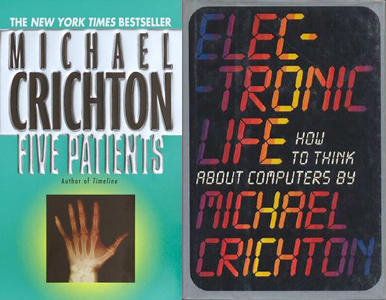Readers who enjoy the explanatory sections of Michael Crichton’s novels – where he goes into history and analysis of issues – should check out his nonfiction works “Five Patients” (1970) and “Electronic Life” (1983). They are fascinating looks into two aspects of life we take for granted: The former is a still-relevant look at hospitals, the latter a layperson’s guide at the advent of home computers.
‘Five Patients’
Not what it promises
Although older, “Five Patients” is the more timeless of the two books, and it has stayed in print. In the 1994 reprint, Crichton says he chose to not revise the text, because it was still relevant. The book isn’t what I expected based on how it’s pitched – the stories of five selected patients, like five “ER” arcs, but not fictionalized.
Although viewers of the “ER” pilot will notice the “Wake at 6:30” sign, and although Crichton starts each section with a story of a patient, these anecdotes are mere framing mechanisms. Sometimes he doesn’t even give us the conclusion of the patient’s story. Instead, he springboards to wider hospital and health care issues.

“Five Patients: The Hospital Explained” (1970)
Author: Michael Crichton
Genre: Nonfiction, analysis on the history and future of hospitals and health care
That’s fine with me, because this is where the text comes alive. In his trademark conversational but compelling manner, Crichton chronicles the primitive days of health care, the innovations through the centuries, and then the first 50 years of modern hospitals.
An impersonal industry
We’ve gone another 50 years since then, but even from my limited perspective, it’s clear modern hospitals have changed less in their second half-century. Crichton gives his thoughts on the cutting-edge tech from his time, including remote doctor consultations – something that didn’t become mainstream until the pandemic forced it to be.
He has an informative section on why health care costs are high, and ways they can be controlled. He only briefly touches on the government-health-care complex as a reason for some high costs. He starts from a point of assumption that everyone wants costs lowered — except when he rips into the American Medical Association, whose entrenched power and influence has been bad for both patients and physicians.
As with all of Crichton’s early books, it’s amazing he was only in his mid-20s when he wrote this perceptive essay collection. One thing he’s unable to do in “Five Patients,” though, is make a reader less intimidated by hospitals and doctors. He openly acknowledges the industry’s impersonal nature.
‘Electronic Life’
A snapshot in time
With “Electronic Life,” though, Crichton aims to comfort and guide the reader. It’s cute to think back on how the layperson felt — perhaps “98 percent fear, 2 percent excited,” to quote “Armageddon” — when home computers went mainstream. “Electronic Life” hasn’t stayed in print (although you can find a copy for $10 or less), as it’s now essentially a time capsule.
The best parts are when Crichton makes predictions about the future, even though that’s not the book’s point (It’s an alphabetical guide to terminology and issues). His most off-the-mark prediction is that machines would become more specialized with time. A year later, we’d see his vision play out in “Runaway,” which finds a robot running Tom Selleck’s kitchen.

“Electronic Life: How to Think About Computers” (1983)
Author: Michael Crichton
Genre: Nonfiction, a practical and analytical layman’s guide to home computers
He suggests the late 20th century will be the only era of the all-purpose computer. But I’m typing this in 2022 on a laptop that does word processing and just about anything else. Even as an extreme tech laggard, I’ve used it for surfing the web, posting to the web, making videos, etc.
Come to think of it, most of my computer use is oriented toward the web. While the terms “World Wide Web” and “internet” aren’t used by the author, he does mention networks (interconnected computers), and he predicts topic-oriented bulletin boards. Those became popular a decade later; one notable use was discussion of TV shows with other fans.
Tied to our computers
Crichton predicts Kindles in a roundabout manner. He thinks of a monitor that stores information rather than merely displaying it. So you would download a book from your desktop computer to your portable monitor and read it on the comfort of your couch. Miniaturization made for smaller computers with built-in screens — although, granted, “monitors with memory” is an alternative way to describe them.
The idea that we’d carry small “monitors with memory” around with us (in the form of smartphones) didn’t occur to Crichton, which is odd because he does highlight a phenomenon I didn’t know about – that everyone carried around calculators when they became pocket-sized and cheap in the 1970s.
The author gets more predictions right than wrong, though, and his central thesis is on point: Computers are here to stay.
Crichton accidentally shames a 21st century reader across time: He says computers won’t take over our lives. Interestingly, he believes computers will improve interpersonal relations – as we learn to communicate with this new tool, we’ll polish our overall communication skills. Here, he was right and wrong: We communicate more easily thanks to computers, but we also communicate less thoughtfully.
It’s too bad Crichton is not around to comment on humanity’s often unhealthy ties to their computers in 2022. Unlike with “Five Patients,” a revised and updated “Electronic Life” would’ve been very different.
Click here to visit our Michael Crichton Zone.
“Five Patients”: 4.5 stars
“Electronic Life”: 4 stars


